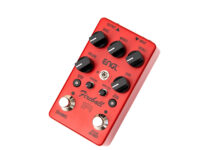
Kernom Elipse review – “a laboratory for anyone looking to expand their tonal horizons”
€369/£369/$369, kernom.com
Why are so many modulation pedals blue? Because they make things wobbly, and the sea is also wobbly, and the sea is blue. Yep, that’s how sophisticated guitarists’ brains are. So there was really no other choice for Kernom when it came to picking a colour for its latest multi-mode stompbox: the Elipse.
READ MORE: Old Blood Noise Endeavors Dark Star Stereo review – taking immersive reverb to the next level
You may have heard of this French company’s first pedal, the Ridge overdrive, and its successor, the Moho fuzz. Both have a ‘mood’ dial that lets you explore a wide range of clipping options, and that idea is carried on here: choose from six different modulation types, or explore the in-between zones for a virtually limitless palette of swirling, pulsing, quivering colours.
Sounds promising, right? And that’s before we even get to the other five controls, which have more secrets to unlock…
Image: Richard Purvis
What is the Kernom Elipse?
Like the first two Kernom pedals, this is a dual-footswitch unit in a chunky aluminium enclosure that looks a bit like Darth Vader’s lunchbox. It’s made in China but certainly doesn’t feel cheap, and weighs in at a reassuring 850g – that’s not far short of two pounds.
Why two footswitches? The second one is for flipping between live mode and a single preset. There’s also an input for an expression pedal that you can use to glide between those two sounds instead; and in case one preset’s not enough, you have the option of MIDI switching for 127 more.
The three knobs on the left are the ‘standard’ ones – speed, depth and wave shape – but it’s on the right side that things get fruity. Time to have a closer look at Kernom’s famous mood selector.
So, the six effect types are harmonic tremolo, rotary, chorus, flanger, phaser and vibe. Note that, as you turn the mix towards maximum, the harmonic tremolo becomes a standard full-frequency trem, and the chorus becomes a simple pitch vibrato. So really that’s eight effects in total… but if you include all the hybrid sounds in the spaces between, you might as well turn that ‘8’ on its side and call it infinity.
Even so, this is a one-effect-at-a-time pedal, right? Not quite – because there are two more hiding in the ‘swirl’ knob on the right, and they can be blended in to taste. Between zero and halfway, you’re adding a slow-ish phaser; between halfway and maximum, the phaser is gradually replaced by a low-gain overdrive that comes after the modulation in the circuit.
Image: Richard Purvis
Is the Kernom Elipse easy to use?
Don’t panic, digi-phobes: the basic operation of this pedal is just as it would be with an all-analogue device. So pick your mood, keep the swirl fully off to begin with, and point everything else upwards – that’s going to be a solid starting point to begin your tone-tweaking adventures.
The preset comes in really handy here: stumble upon a sound you really like, and all you have to do is hold down the left footswitch for two seconds to store it. Now every tap of the switch will toggle between this sound and wherever the controls are set.
Using an expression pedal doesn’t even require any kind of setup, as it’s simply a more advanced version of the same function: heel is live, toe is preset, and everything in between is… well, everything in between. So that’s a whole other level of morphing flexibility – or, for Leslie and Uni-Vibe fans, maybe just an easy way to move between fast and slow settings.
Image: Richard Purvis
What does the Kernom Elipse sound like?
What sort of mood are you in today? I’m feeling harmonic tremolo-y, which is a coincidence because that’s the first one on the dial. And it’s a winner: a smoothly pulsating trem sound with a lovely tang of added phasey sweetness. You can tone that down by pushing the mix past noon, and also fine-tune the character of the modulation by changing its shape, for a thicker pulse width to the left or something more staccato to the right.
That’s a fine start, but what happens if we twist just a little way towards the rotary effect? You can hear the chorus-like waves seep in discreetly, until you reach a tipping point where it’s rotary with some added trem rather than the other way round. There’s nothing in this blended zone that I’d call a whole new species of modulation, but you will find interesting and usable sounds that don’t exist in any single-effect pedal – and that’s equally true of the other four in-between sectors.
As for the core sounds themselves, they’re all strong – although the rotary can’t compete with a good digital Leslie simulator, and Uni-Vibe purists won’t be changing their minds about the sanctity of LDRs – but the Elipse’s real selling point is the way you can blend effects in multiple ways. Use mix to fade between chorus and vibrato, then mood to introduce a touch of flanging… and then swirl to run the whole thing through a phaser. Wobbles don’t come wobblier than this.
Image: Richard Purvis
That bonus phaser doesn’t arc quite as slowly as I was hoping it might, but it’s low-key enough not to trample all over the main effect. The overdrive, meanwhile, is not so much a full-on cruncher as a gentle mids-boosting thickener – imagine something like an extra-low-gain Klon. In theory the drive should take over completely from the phaser when set to maximum; in practice, the swirliness never seems to quite go away completely.
Now we come to a couple of minor quibbles and one potentially bigger one. Firstly, the Elipse didn’t get on very well with my ever-trusty Moog EP-3 expression pedal, pulling up short of higher preset speeds even with the toe fully down. And there’s also a slight issue with output volume: Kernom says this is always consistent, but the secondary phaser does take a noticeable scoop out of the midrange.
Finally, you might have noticed the words “For mono rigs only” in the verdict above. That’s not only a reference to the single output: it’s also a warning to anyone who likes using modulation pedals on one side of a stereo setup. Kernom’s processing may be analogue but the digital control system does involve signal conversion, and this adds a sliver of latency to the pedal’s output – not enough to be audible, but enough to knock it out of phase with anything running parallel. I tried the Elipse in a two-amp rig with an ABY switch and the bass-strangling result was not pretty.
Should I buy the Kernom Elipse?
Maybe you already have a harmonic tremolo, a rotary sim, a chorus, a flanger, a phaser and a vibe pedal. Is it time to catapult them all into the nearest active volcano? No. But as a practical alternative to two or three of them, and a smart way to create new hybrid modulation tones, the Elipse is absolutely worth considering. Yes, it has flaws that will bother some players more than others, but that shouldn’t detract from the cleverness – and usefulness – of what Kernom has done here.
Kernom Elipse alternatives
Offering multiple modulation effects in one box is not a new idea, but the Elipse’s main rivals are all digital: the Strymon Mobius (£369), Walrus Audio M1 (£379), UAFX Astra (£379) and Wampler Terraform (£299). There is one analogue pedal that covers some of this territory, though: the Hamstead Redwing (£429).
The post Kernom Elipse review – “a laboratory for anyone looking to expand their tonal horizons” appeared first on Guitar.com | All Things Guitar.
Source: www.guitar-bass.net












